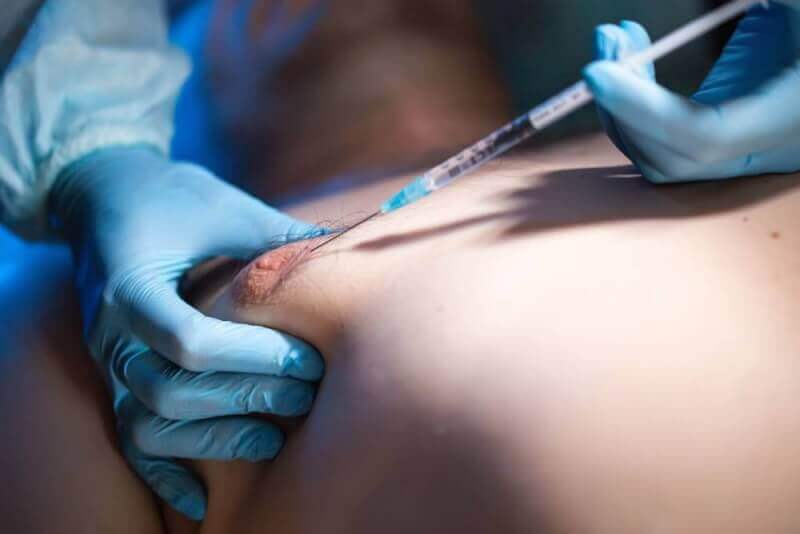What is Gynecomastia?
Although it is a disease of male metabolism, gynecomastia is a disorder that occurs due to hormonal imbalance. In this disease, there is an imbalance of estrogen and testosterone hormones in the male body. This imbalance causes men to have a larger amount of breast tissue than they should.
While breast tissue growth is seen due to hormonal imbalance in gynecomastia, this growth is a benign growth. Although some men may have one breast and some men may have both breasts enlarged, both breasts may be affected by this hormone imbalance in an irregular manner and may be of different sizes.
What are the Symptoms of Gynecomastia?
Among the clearest symptoms of gynecomastia, the appearance of a swollen breast tissue comes first. In addition, if there is tenderness in male breasts in this disorder, it is also considered as a symptom of gynecomastia.
Some symptoms may indicate that the condition has reached a significant stage and may be a problem. For example, problems such as pain in the breast, a very tender structure and swelling, and when one or both breasts are full, should be considered important symptoms. In fact, it is important to consult a doctor at the earliest opportunity in case of these symptoms, especially if there is discharge from one or both nipples.
What Causes Gynecomastia?
In men, unbalanced levels of testosterone hormone are among the most important factors causing gynecomastia. The reasons for the decline of the testosterone hormone behind this condition should be considered. Because conditions that block the effects of testosterone, reduce hormone secretion and increase estrogen secretion are among the causes of gynecomastia.
The balance of hormones in the human body can be disturbed for different reasons. In terms of gynecomastia, hormone changes that you can experience naturally, excessive alcohol use, smoking, drug use, different health conditions, regular use of certain medications and uncontrolled use of herbal products can be hormone disorders.
In both men and women, both sexes secrete testosterone and estrogen hormones. In men, however, when testosterone is secreted in excess, muscle mass increases, body hair and other masculine characteristics are restored. In women, estrogen is secreted in excess, controlling both breast growth and other female characteristics.
Although estrogen is basically defined as the female hormone, it is also normally secreted in low amounts in men. If estrogen is secreted in a male body to a degree above normal, it is often the cause of gynecomastia because it is out of balance with testosterone levels.
Congenital gynecomastia is usually caused by the growth of male babies in the womb before birth due to the effect of estrogen. This problem usually disappears a few weeks after birth.
While gynecomastia is commonly caused by fluctuating hormone levels during puberty, in cases that occur during puberty, the swollen breast tissue may disappear without treatment. Gynecomastia symptoms can be seen in one out of every 4 men in this age group due to gynecomastia, which increases again in later periods, i.e. in adulthood between the ages of 50-69.
When the causes of gynecomastia, which can be counted in a much more general way, are examined
- Antiandrogens such as prostate and cancer medicines
- Drugs to increase muscle mass, steroids and androgens, often used in athletes or young people
- Certain antidepressants and heart medicines
- Medicines for the treatment of hyperactivity and attention deficit
- Pituitary insufficiency or disorders affecting hormone balance
- Hormone changes that occur as a result of aging
- Tumors that cause imbalance in the testis, adrenal gland and pituitary gland
- Renal failure and dialysis treatment
- Medicines for liver problems and especially cirrhosis
- There are points such as malnutrition and excessive hunger.
How is Gynecomastia Diagnosed?
In order to diagnose gynecomastia, a physical examination is performed by a doctor. After the patient's own history and family history, the patient's health history is investigated to reveal the symptoms much more clearly. At this point, it is important that the patient conveys absolutely all the symptoms and problems they feel to the doctor.
If the physical examination process is not sufficient, blood tests should be performed for the diagnosis of gynecomastia and imaging methods such as computed tomography and magnetic resonance should be used depending on these results. In certain cases, testicular ultrasound and tissue biopsy may be required to diagnose more advanced gynecomastia.
It is important to be sure of the diagnosis as some patients may develop breast swelling and similar symptoms, just like the gynecomastia process. Because some patients may have excessive fatty breast tissue. Some patients may also have a layer of breast fat, which has a similar structure to gynecomastia. In such cases, methods separate from gynecomastia treatment are used.
How is Gynecomastia Treated?
Gynecomastia, which can be encountered during puberty or due to different reasons, usually has a structure that can correct itself. However, some patients may experience a condition that adversely affects quality of life, causing very high levels of pain, increased sensitivity and psychological problems. In this case, it is usually possible to provide treatment with medication and surgical intervention at a later point.
Gynecomastia Surgery
If gynecomastia is in a progressive position that cannot be treated despite the use of medication, gynecomastia surgery may be required. There are two different surgical operation systems that are generally preferred in this regard.
The first method, liposuction, is actually a method preferred for aesthetic and health concerns at many different points. Liposuction, also called fat suction surgery, is performed by a doctor and only the fat in the breast tissue is removed. But the breast tissue remains in place.
Another method, mastectomy surgery, is a professional method applied in the operating room environment. For this delicate gynecomastia surgery, the mammary gland tissue is completely removed from the body thanks to the use of small incisions with very modern systems.
The two methods that can be chosen in terms of surgery have differences from each other in terms of application and outcome. However, in terms of the price of gynecomastia surgery, differences can also be seen in both operations in terms of both institutional sense and quality.
Things to Consider After Gynecomastia Surgery
After the application of one of the two methods such as liposuction or mastectomy in terms of gynecomastia, there are points that the patient should pay attention to for the successful completion of the treatment process. Generally, different findings may occur after surgery depending on the technique of the surgery. According to the findings, the sensitivities recommended by the doctor should be followed.
Gynecomastia surgery is usually a procedure performed under general anesthesia, but very rarely local anesthesia may be preferred. While the patient is usually discharged on the day the operation is completed, there is a possibility of edema and swelling in the operation area on the same day.
It is possible to experience mild muscle pain after mastectomy surgery. During this process, medications recommended by the doctor can be used and a good rest period of at least 3 days will be required. Especially the corset given for use after the operation must be used regularly for 3-4 weeks.







